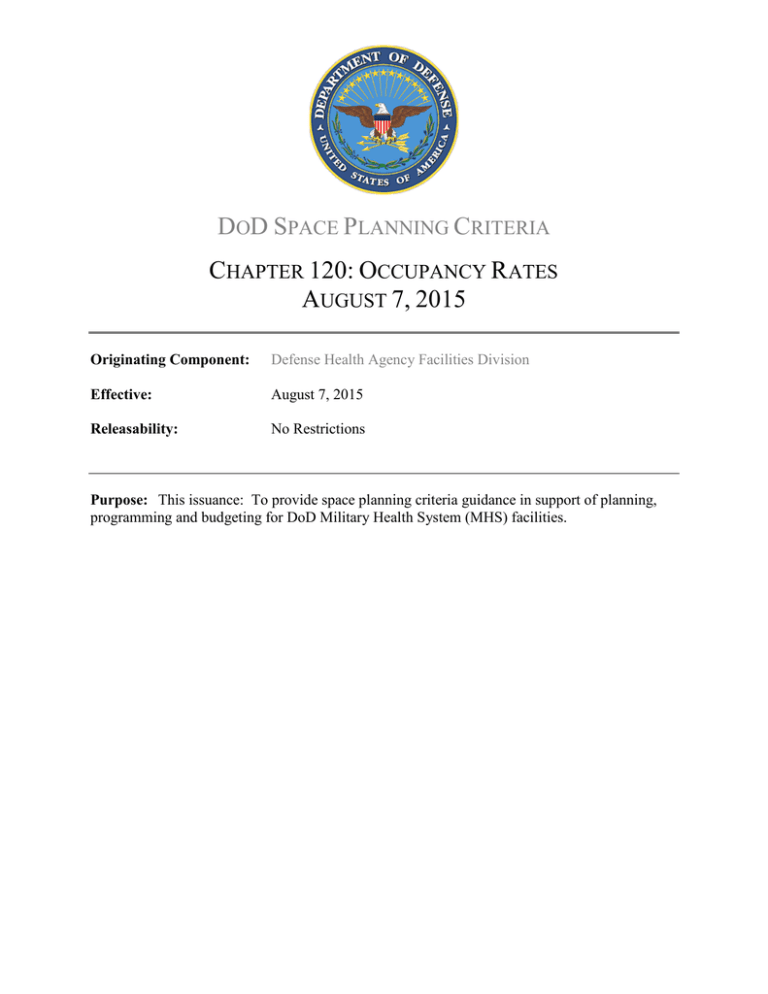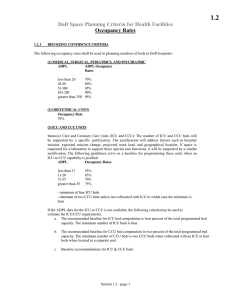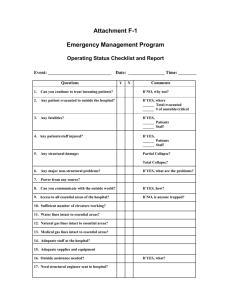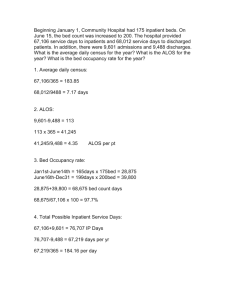D S P C
advertisement

DOD SPACE PLANNING CRITERIA CHAPTER 120: OCCUPANCY RATES AUGUST 7, 2015 Originating Component: Defense Health Agency Facilities Division Effective: August 7, 2015 Releasability: No Restrictions Purpose: This issuance: To provide space planning criteria guidance in support of planning, programming and budgeting for DoD Military Health System (MHS) facilities. DoD Space Planning Criteria Chapter 120: Occupancy Rates August 7, 2015 TABLE OF CONTENTS SECTION 1: PURPOSE AND SCOPE .............................................................................................. 3 SECTION 2: BED SIZING CONFIDENCE CRITERIA .................................................................. 4 SECTION 3: PLANNING EXAMPLES ........................................................................................... 6 2 DoD Space Planning Criteria Chapter 120: Occupancy Rates August 7, 2015 SECTION 1: PURPOSE AND SCOPE 1.1. PURPOSE AND SCOPE The Office of the Assistant Secretary of Defense for Health Affairs (ASDHA) has primary responsibility for establishing functional space and equipment planning criteria and standards for all the facilities in the Military Health System (MHS). The purpose of this document is to outline the way the Space and Equipment Planning documents are organized in order to facilitate planning, programming, and budgeting for DoD Medical Facilities for all services. Space Planning Criteria is organized by Chapter, a chapter corresponds to a Department or Departments with similar clinical functions in a healthcare facility. The intent of the Space Planning Criteria chapters and their implemented version in SEPS is to aid the space planner working on a MHS project create a baseline Space Program, Program for Design (PFD) and a Program Room Contents (PRC) using DoD approved standards. The Space and Equipment Planning documentation is available on the World-Class Facilities website at the following link: https://facilities.health.mil/home/. It is accessible from the home page under “CONNECT” and selecting the SPC icon. 3 DoD Space Planning Criteria Chapter 120: Occupancy Rates August 7, 2015 SECTION 2: BED SIZING CONFIDENCE CRITERIA 2.1. BED SIZING CONFIDENCE CRITERIA. The following hospital inpatient occupancy rates shall be used in planning the number of beds in MTFs. The occupancy rates selected will then be applied to the formula for determining bed needs, located in their respective chapters (Chapter 410: Nursing Units (Med-Surg, Peds, ICU / CCU, Substance Abuse/Alcohol Rehab, Chapter 420: Labor & Delivery / Obstetric Unit and Chapter 460: Behavioral Health Inpatient Unit). Table 1: CHAPTER 410: NURSING UNITS BED OCCUPANCY RATES Medical-Surgical Units ADPL Beds Less than 26 26-50 51-100 101-250 Greater than 250 ICU / CCU Units ADPL Occupancy Rates 60% 75% 80% 85% 90% ADPL Beds 8 or greater Pediatric Units ADPL Occupancy Rates 60% ADPL Beds ADPL Occupancy Rates Less than 31 65% Greater than 31 75% Substance Abuse / Alcohol Rehabilitation Units ADPL Beds 8 or greater ADPL Occupancy Rates 90% Table 2: CHAPTER 420: LABOR AND DELIVERY / OBSTETRIC UNITS BED OCCUPANCY RATES Obstetric Units ADPL Beds Less than 11 Greater than 11 ADPL Occupancy Rates 60% 75% A. Intensive Care and Coronary Care Units (ICU / CCU): The total number of critical care beds will be supported by a specific justification. The justification will address factors such as hospital mission, expected mission change, projected 4 DoD Space Planning Criteria Chapter 120: Occupancy Rates August 7, 2015 work load, and geographical location. If space is requested for a laboratory to support these special care functions, it will be supported by a similar justification. The following guidelines serve as a baseline for programming these units when Intensive Care and / or Coronary Care Unit capability is justified. If the ADPL data for the ICU / CCU is not available, the following criteria may be used to estimate the ICU / CCU bed requirements. a. The recommended baseline for number of critical care beds (i.e., total ICU and CCU beds) is 13 percent of the total programmed bed capacity. b. The minimum number of ICU / CCU beds per Unit is eight. Table 3: RECOMMENDED NUMBER OF ICU / CCU BEDS c. MTF Total Bed Capacity 99 or less 100 - 199 200 - 299 300 - 399 400+ Number of ICU / CCU Beds 8 - 13 13 - 26 26 - 39 39 - 52 Authorization Required 5 DoD Space Planning Criteria Chapter 120: Occupancy Rates August 7, 2015 SECTION 3: PLANNING EXAMPLES 3.1. PLANNING EXAMPLES. Case 1: Bed calculation using ADPL projections (including ICU / CCU) Based on the following ADPL projections: 1. 2. 3. 4. 5. 6. Medical- Surgical = 150 Pediatrics = 8 Substance Abuse / Alcohol Rehab = 10 Behavioral Health Inpatient = 8 Obstetric (Postpartum/Antepartum) = 15 ICU / CCU = 16 Calculation: Medical-Surgical beds = Pediatric beds = Substance Abuse / Alcohol Rehab = Behavioral Health Inpatient beds = Obstetric (Postpartum/Antepartum) beds = ICU / CCU beds = 150 0.85 8 0.65 10 0.90 8 0.90 15 0.75 16 0.60 = 177 = 13 = 12 = 9 = 20 = 27 Total = 258 beds Case 2: Bed calculation using ADPL projections (excluding ICU / CCU) Based on the following ADPL projections: 1. 2. 3. 4. 5. Medical-Surgical= 150 Pediatrics = 8 Substance Abuse / Alcohol Rehab = 10 Behavioral Health = 8 Obstetric = 15 6 DoD Space Planning Criteria Chapter 120: Occupancy Rates August 7, 2015 Calculation: Medical-Surgical beds = Pediatric beds = Substance Abuse / Alcohol Rehab beds = Behavioral Health Inpatient beds = Obstetric (Postpartum/Antepartum beds) = 150 0.85 8 0.65 10 0.90 8 0.90 15 0.75 = 177 = 13 = 12 = 9 = 20 Total = 231 beds ICU / CCU beds calculated as a percentage: ICU / CCU beds = (231)(0.13) = 30.03 = 31 Total Number of Beds + 231 + 31 = 262 7






